

Copyright guide 8.5 x 11. The Educator's Guide to Creativity & Copyright. Webinar Recording - Copyright & Creative Commons for K-12 Educators. Yesterday afternoon I hosted a free webinar titled Copyright & Creative Commons for K-12 Educators.
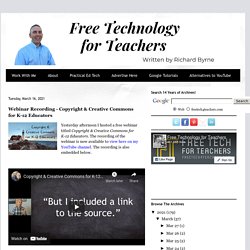
The recording of the webinar is now available to view here on my YouTube channel. The recording is also embedded below. Here's a list of the resources that I included in the webinar: Lessons from the $9.2 million copyright judgment against Houston ISD Crash Course Intellectual Property. Copyright for Students. Teaching Students to Legally Use Images Online. Image Citation - Copyright Educational Resources - Research Guides at University of British Columbia. How to give attribution. Here is a photo. Following it are some examples of how people might attribute it. This is an ideal attribution “Creative Commons 10th Birthday Celebration San Francisco” by tvol is licensed under CC BY 2.0 Because: Title? How you attribute authors of the CC works will depend on whether you modify the content, if you create a derivative, if there are multiple sources, etc.
Best practices for attribution. You can use CC-licensed materials as long as you follow the license conditions. One condition of all CC licenses is attribution. Here are some good (and not so good) examples of attribution. How To Properly Search For and Attribute Creative Commons Photos.
If your students are content creators (and honestly, most of them are), they already know that high-quality images make their work stand out.
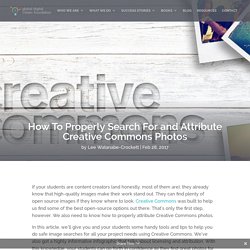
They can find plenty of open source images if they know where to look. Creative Commons was built to help us find some of the best open-source options out there. That’s only the first step, however. #notataasl. How to Search OER Commons. Best practices for attribution - Creative Commons. Copyright and Creative Commons are friends. Interesting video, although somewhat regionally-centric.
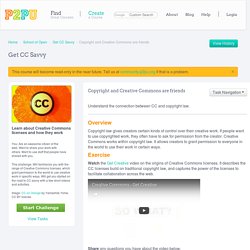
Overall I love the underlying altruistic idea of CC. Certainly in education we are eternally running into the issue of copyright vrs copywrong... My understanding is that ©, the opponomous "Big C" was not generally legally required elsewhere in the world apart from in the US prior to 1989, when the USA ratified the Berne Convention of 1886. [New Zealand became signatory in 1928] In my classes I have several times run into the "regionalisation" issue. In my learning area my students and myself have frequently come across music video "mash-ups" being created in off-shore educational establishments [some really exciting and engaging tasks] and shared under an understanding of Fairuse. Fair_dealing#New_Zealand In New Zealand, fair dealing includes some copying for private study, research, criticism, review, and news reporting. What the act does cover is referenced here: What Is Creative Commons and Why Does It Matter?
As K-12 educators, you face unique challenges when it comes to using the Web.
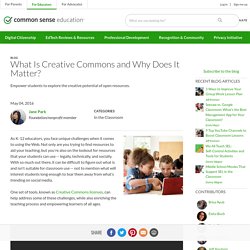
Not only are you trying to find resources to aid your teaching, but you're also on the lookout for resources that your students can use -- legally, technically, and socially. With so much out there, it can be difficult to figure out what is and isn't suitable for classroom use -- not to mention what will interest students long enough to tear them away from what’s trending on social media. One set of tools, known as Creative Commons licenses, can help address some of these challenges, while also enriching the teaching process and empowering learners of all ages. Best practices for attribution - Creative Commons. OpenAttribute.
A Copyright-Friendly Toolkit. However fabulous Creative Commons and Public Domain content may be, sometimes you really need to use copyrighted material. Say you plan to comment on popular media or current events. For instance, you may be planning to critique the portrayal of Native Americans in commercial films. You are going to want to “quote” some commercial films like Pocahontas, Lone Ranger, and Dances with Wolves. If you are reviewing a book, you may want to share its cover art. You may use copyrighted content without asking permission if you believe that your use falls under the doctrine known as Fair Use.
In general, when you transform original content, repurpose it, and add value to it in your own remix, you may be able to claim the use fair. According to American University’s Center for Media and Social Impact, these two tests or questions help you plan whether to use the copyrighted work of others without asking permission: The video below explains why the Code for Fair Use in Online Video was created. Copyright Advisory Office Home. Search High Quality Flickr Images.
Free To Use and Share: Resources To Help Teach Kids (and Adults!) About Copyright and Creative Commons. I've gotten a few requests lately for resources on how to teach kids (and adults!)
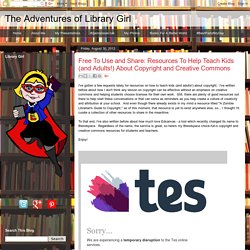
About copyright. I've written before about how I don't think any lesson on copyright can be effective without an emphasis on creative commons and helping students choose licenses for their own work. Still, there are plenty of good resources out there to help start these conversations or that can serve as reminders as you help create a culture of creativity and attribution at your school. And even though there already exists in my mind a resource titled "A Zombie Librarian's Guide to Copyright," as of this moment, that resource is yet to exist anywhere else, so... I thought I'd curate a collection of other resources to share in the meantime.
To that end, I've also written before about how much love Edcanvas - a tool which recently changed its name to Blendspace. Enjoy! Direct link to this blendspace. What Is Creative Commons, And Should You Use It? While writing out your next academic paper, you look online for various images which are appropriate for what you’re talking about.
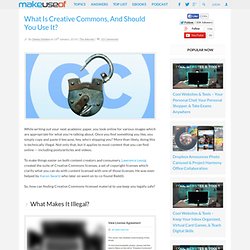
Once you find something you like, you simply copy and paste it because, hey, who’s stopping you? More than likely, doing this is technically illegal. Not only that, but it applies to most content that you can find online — including posts/articles and videos. To make things easier on both content creators and consumers, Lawrence Lessig created the suite of Creative Commons licenses, a set of copyright licenses which clarify what you can do with content licensed with one of those licenses.